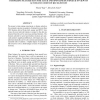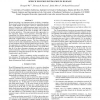6 search results - page 1 / 2 » Comparing Feature Sets for Acted and Spontaneous Speech in V... |
ICMCS
2005
IEEE
13 years 10 months ago
2005
IEEE
We present a data-mining experiment on feature selection for automatic emotion recognition. Starting from more than 1000 features derived from pitch, energy and MFCC time series, ...
PAMI
2008
13 years 4 months ago
2008
Little attention has been paid so far to physiological signals for emotion recognition compared to audiovisual emotion channels such as facial expression or speech. This paper inve...
ICMCS
2006
IEEE
13 years 10 months ago
2006
IEEE
Feature sets are broadly discussed within speech emotion recognition by acoustic analysis. While popular filter and wrapper based search help to retrieve relevant ones, we feel th...
ICMCS
2010
IEEE
13 years 4 months ago
2010
IEEE
Speech processing is an important aspect of affective computing. Most research in this direction has focused on classifying emotions into a small number of categories. However, nu...
CSL
2011
Springer
12 years 11 months ago
2011
Springer
The automatic recognition of user’s communicative style within a spoken dialog system framework, including the affective aspects, has received increased attention in the past f...


